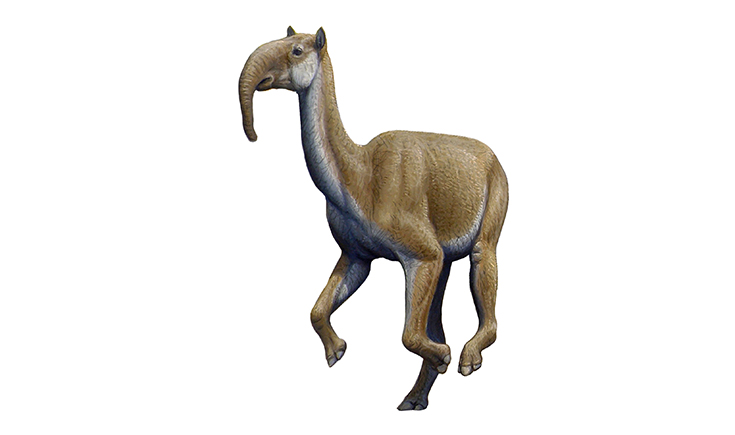3D models of the first specimen of Macrauchenia patachonica known to science are now available online. It was found by Charles Darwin on the Voyage of the Beagle in 1834.
Researchers have 3D-surface-scanned all of the surviving bones collected by Darwin and combined this with a scientifically accurate illustration so that people around the world can study this important scientific discovery.
But what kind of creature was Macrauchenia?
Macrauchenia is the scientific name for an extinct plant-eating mammal from South America, belonging to an extinct group of mammals called the litopterns. The best-known species is M. patachonica. In 2015, fragments of collagen were extracted from its bones and showed that its closest living relatives are the perissodactyls - horses, rhinos and tapirs.
Darwin collected thousands of plant, animal, rock and fossil specimens on the Voyage of the Beagle (1831-1836), including 13 species of fossil mammal. The latter include four different species of giant ground sloth, the remains of an extinct type of horse and two species of hoofed mammal, one of which was Macrauchenia.
M. patachonica was first described by Richard Owen based on specimens collected by Darwin. Owen noted an anatomical detail in the neck vertebrae that matched a feature unique to the camel family, and excitedly described the species as 'a giant llama'.
Both he and Darwin were struck by the apparent similarity between these extinct and living mammals of South America, and Darwin wondered whether 'one species does change into another' - thoughts that would later become solidified theories of evolution.
However, Macrauchenia feet had three toes, unlike the two-toed camels, so Owen had to abandon the llama idea. Nevertheless, the generic name that Owen chose, Macrauchenia, came from the Greek words 'macros' (long) and 'auchen' (neck), reflecting the scientific name then in use for the llama, Auchenia.
The last of its kind
Since then, more Macrauchenia fossils have been found, mainly in Argentina but also in other South American countries. The oldest fossils date to the Late Miocene, around seven million years ago, and M. patachonica disappears from the fossil record around 12,000-10,000 years ago. It is the last and best-known member of the litoptern family and often reconstructed to look like a cross between a llama and an elephant, although it is not closely related to either.
Later finds showed Macrauchenia to be the last surviving member of a larger group, named the litopterns by the Argentinian palaeontologist Florentino Ameghino in 1889. The litopterns arose approximately 60 million years ago and adult members of the group spanned a range of body sizes from about 40 kilogrammes. M. patachonica was a relatively large animal, probably weighing about 1,000 kilogrammes and around three metres in length.

Macrauchenia reconstruction by Mauricio Anton
Exact causes behind the extinction of M. patachonica are not fully understood, although climate change and its effects on vegetation were almost certainly partly responsible.
Explore Macrauchenia patachonica online
The M. patachonica 3D models join the Darwin fossil mammals dataset on the Museum's Data Portal. They are also available to view on Sketchfab, a 3D modelling platform.
The partial skeleton that Darwin collected was in multiple pieces. We have used 3D technology to piece the skeleton back together into a 3D reconstruction of the animal to share an entirely new resource with the world. We hope that by sharing this reconstruction we can bring to life this animal that lived up to seven million years ago, in an entirely different habitat to modern day South America.
These fossil mammals collected by Darwin are historically and scientifically important, but also very fragile. Access to these specimens had been restricted to protect them from further damage.
By creating and openly releasing digital versions of Darwin's fossils on the Data Portal, we hope to increase access and use of the specimens online.
The previously released Toxodon, Mylodon and Megatherium models have been viewed thousands of times and downloaded and printed all over the world. They have been used in engagement activities in the Museum and elsewhere including by researchers at in the Western Science Centre in California (USA), during talks to English Heritage at Darwin's Down House and at the Chilean Congress of Palaeontology. In 2019, a Mylodon darwinii mandible cast was gifted from the Museum to the Charles Darwin Museum, Argentina .
Related information
- Follow us on @NHM_Digitse and @NHMFossilMammal to hear more about the Museum's digitisation of its 80 million specimens.
- Data from the Macrauchenia scans are on the Museum's Data Portal and Sketchfab.
- Tell us how you would like to use these models by emailing digitalcollections@nhm.ac.uk.
- The pilot has been funded by the Hartnett Conversation Trust and the Leche Trust.
Digital collections blog
Catch up with the latest digitisation techniques and technology.
Don't miss a thing
Receive email updates about our news, science, exhibitions, events, products, services and fundraising activities. We may occasionally include third-party content from our corporate partners and other museums. We will not share your personal details with these third parties. You must be over the age of 13. Privacy notice.
Follow us on social media